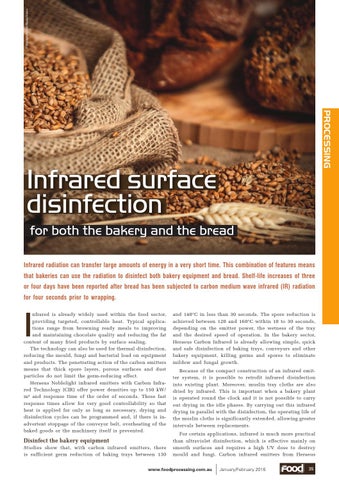© iStockphoto.com/Alexey Ivanov
PROCESSING
Infrared surface disinfection for both the bakery and the bread Infrared radiation can transfer large amounts of energy in a very short time. This combination of features means that bakeries can use the radiation to disinfect both bakery equipment and bread. Shelf-life increases of three or four days have been reported after bread has been subjected to carbon medium wave infrared (IR) radiation for four seconds prior to wrapping.
I
nfrared is already widely used within the food sector, providing targeted, controllable heat. Typical applications range from browning ready meals to improving and maintaining chocolate quality and reducing the fat content of many fried products by surface sealing. The technology can also be used for thermal disinfection, reducing the mould, fungi and bacterial load on equipment and products. The penetrating action of the carbon emitters means that thick spore layers, porous surfaces and dust particles do not limit the germ-reducing effect. Heraeus Noblelight infrared emitters with Carbon Infrared Technology (CIR) offer power densities up to 150 kW/ m² and response time of the order of seconds. These fast response times allow for very good controllability so that heat is applied for only as long as necessary, drying and disinfection cycles can be programmed and, if there is inadvertent stoppage of the conveyor belt, overheating of the baked goods or the machinery itself is prevented.
Disinfect the bakery equipment Studies show that, with carbon infrared emitters, there is sufficient germ reduction of baking trays between 130
and 140°C in less than 30 seconds. The spore reduction is achieved between 120 and 160°C within 10 to 30 seconds, depending on the emitter power, the wetness of the tray and the desired speed of operation. In the bakery sector, Heraeus Carbon Infrared is already allowing simple, quick and safe disinfection of baking trays, conveyors and other bakery equipment, killing germs and spores to eliminate mildew and fungal growth. Because of the compact construction of an infrared emitter system, it is possible to retrofit infrared disinfection into existing plant. Moreover, muslin tray cloths are also dried by infrared. This is important when a bakery plant is operated round the clock and it is not possible to carry out drying in the idle phases. By carrying out this infrared drying in parallel with the disinfection, the operating life of the muslin cloths is significantly extended, allowing greater intervals between replacements. For certain applications, infrared is much more practical than ultraviolet disinfection, which is effective mainly on smooth surfaces and requires a high UV dose to destroy mould and fungi. Carbon infrared emitters from Heraeus
www.foodprocessing.com.au
January/February 2016
35
